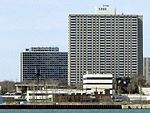Historic Trinity Lutheran Church
1850 establishments in Michigan19th-century Lutheran churches in the United StatesChurches completed in 1927Churches in DetroitChurches on the National Register of Historic Places in Michigan ... and 6 more
German-American culture in DetroitLutheran Church – Missouri Synod churchesLutheran churches in MichiganMichigan State Historic SitesNational Register of Historic Places in DetroitReligious organizations established in 1850

The Historic Trinity Lutheran Church is a church located in downtown Detroit, Michigan. It occupies the Trinity Evangelical Lutheran Church complex, located at 1345 Gratiot Avenue. It was designated a Michigan State Historic Site in 1981 and listed on the National Register of Historic Places in 1983. Its current pastor is Rev. Darryl L. Andrzejewski.
Excerpt from the Wikipedia article Historic Trinity Lutheran Church (License: CC BY-SA 3.0, Authors, Images).Historic Trinity Lutheran Church
Gratiot Avenue, Detroit
Geographical coordinates (GPS) Address Phone number Website External links Nearby Places Show on map
Geographical coordinates (GPS)
| Latitude | Longitude |
|---|---|
| N 42.342777777778 ° | E -83.039722222222 ° |
Address
Historic Trinity Lutheran Church
Gratiot Avenue 1355;1345
48207 Detroit
Michigan, United States
Open on Google Maps









